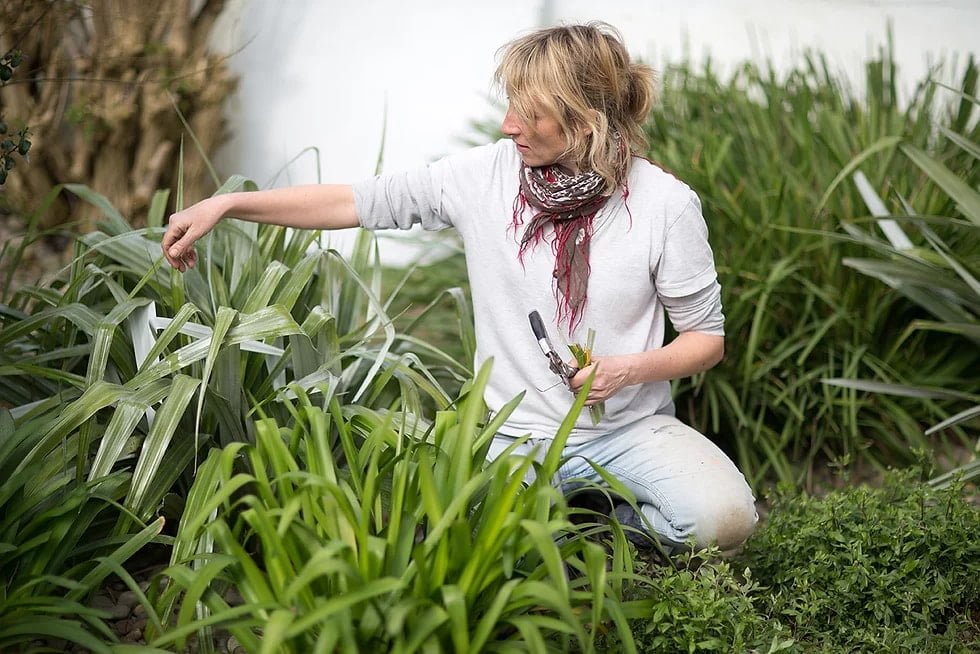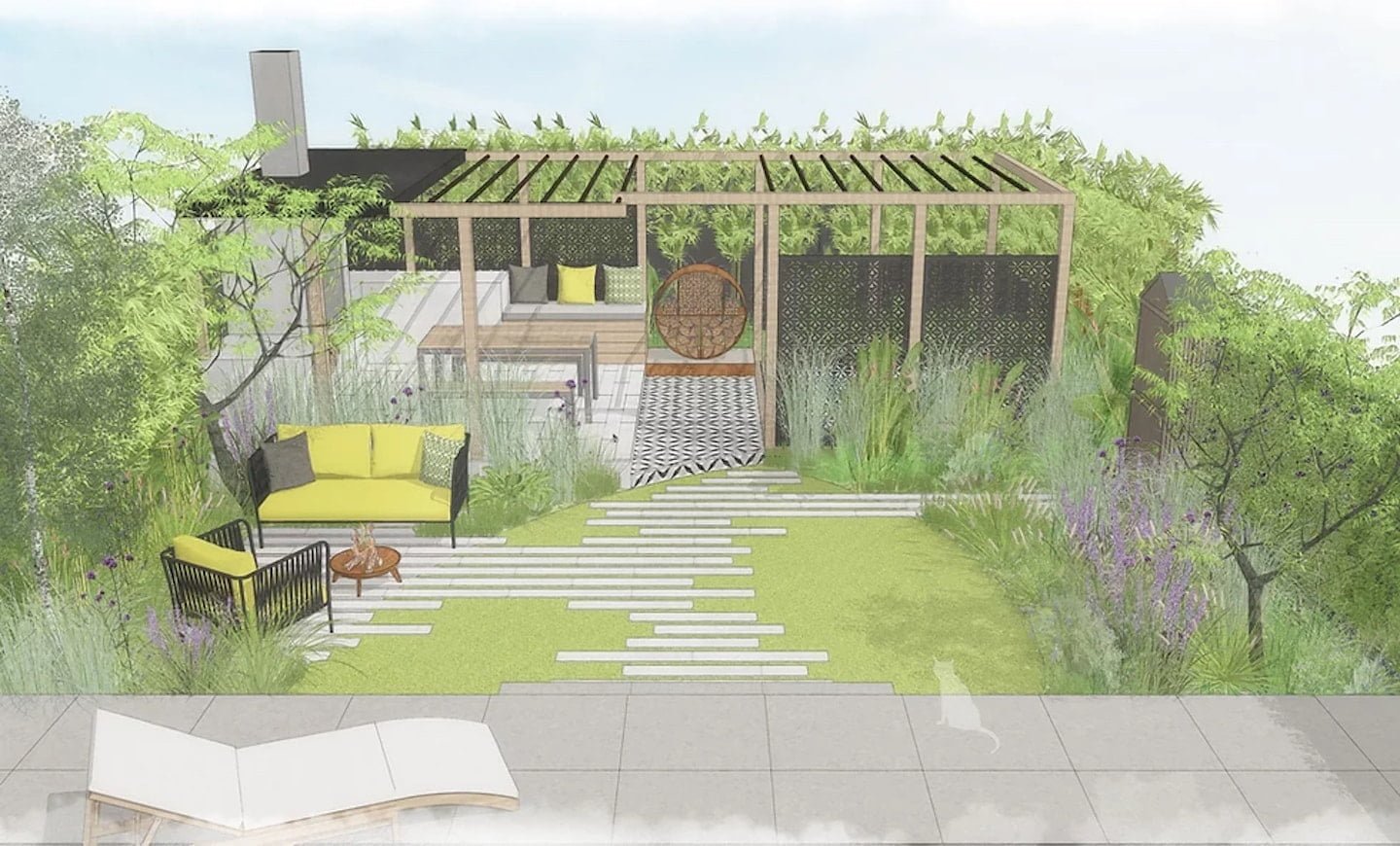Sketches and CAD in Garden Design
A well-designed garden can be a beautiful and relaxing space to enjoy, whether you’re entertaining guests or simply spending time on your own or with friends and family. But creating a stunning garden takes more than just planting some flowers and shrubs. It requires careful planning and design, and two of the most important tools for garden designers are sketches and CAD. Read on to discover more in this incredibly in depth guest blog post by garden designer Rachel Goozee.
Initial Garden Sketches
Sketches are a great way to capture your initial ideas for a garden design. They allow you to quickly and easily experiment with different layouts and features, and they can be a helpful way to communicate your vision to clients. When sketching a garden design, it’s important to be as detailed as possible. Include the size and shape of the garden, the location of existing features, and your ideas for new plantings, hardscaping, and water features. You should also label all of the elements in your sketch, so that clients can easily understand your plan.
Paper vs Digital
Traditionally, garden designers have used pencil and paper to create their sketches and plans. However, in recent years, digital drawing tools have become increasingly popular. There are several advantages to using digital drawing tools, including:
- Accuracy: Digital drawing tools allow you to create accurate and precise drawings. This is essential for ensuring that the garden design is built correctly.
- Detail: Digital drawing tools allow you to create detailed drawings that document all aspects of the garden design. This information is essential for contractors and for ensuring that the garden is built to the designer’s specifications.
- Communication: Digital drawings can be easily shared with clients, contractors, and other stakeholders. This allows everyone to see the garden design in detail and to provide feedback.
- Time savings: Digital drawing tools can save time by automating many of the tasks involved in garden design. This includes tasks such as creating plans, generating planting lists, and calculating quantities of materials.
However, there are also some disadvantages to using digital drawing tools, including:
- Cost: Digital drawing tools can be more expensive than traditional pencil and paper.
- Learning curve: It can take some time to learn how to use digital drawing tools effectively.
- Creativity: Some people find that digital drawing tools can stifle their creativity.
Ultimately, the best way to create garden designs is to use the tools that work best for you. If you are comfortable with traditional pencil and paper, then there is no need to switch to digital drawing tools. However, if you are looking for a more accurate, detailed, and efficient way to create garden designs, then digital drawing tools may be a good option for you.
Garden Design Software
here are some of the garden design software available to designers for end user developments in the UK:
- Garden Planner 3D: This software is a popular choice for both professional and amateur garden designers. It allows users to create detailed 2D and 3D plans of their gardens, and it includes a wide range of plant and object libraries.
- Landscaping Plus: This software is another popular choice for garden designers. It is a bit more complex than Garden Planner 3D, but it offers more features, such as the ability to create water features and landscape lighting.
- Sweet Home 3D: This software is a free and open-source option for garden designers. It is not as powerful as some of the other options on this list, but it is a good choice for those who are looking for a free and easy-to-use tool.
- SketchUp: This software is a popular choice for architects and interior designers, but it can also be used for garden design. It is a powerful tool that allows users to create detailed 3D models of their gardens.
- AutoCAD: This software is a professional-grade CAD software that is used by architects, engineers, and other professionals. It is a powerful tool that can be used to create detailed 2D and 3D drawings of gardens.
These are just a few of the garden design software available to designers in the UK. The best software for you will depend on your individual needs and preferences. If you are a professional garden designer, you may need a powerful software like AutoCAD. If you are an amateur garden designer, you may be able to get by with a simpler software like Garden Planner 3D.
In addition to these software options, there are also a number of online garden design tools available. These tools are typically less powerful than the software options listed above, but they can be a good way to get started with garden design. No matter what your budget or experience level, there is a garden design software or tool available that can help you create the garden of your dreams.
Some popular online garden design tools include:
- Gardenista: This website offers a variety of tools for garden design, including a 3D garden planner and a plant library.
- Houzz: This website is a great resource for home improvement inspiration, and it also offers a garden design tool.
- Easy Garden Design: This website offers a simple and easy-to-use garden design tool.
- Shoot Gardening: Great gardening tool to design simple schemes and planting plans.
Scale and Proportion in Garden Design
Scale and proportion are two important principles of garden design. Scale refers to the relative size of objects in a garden, while proportion refers to the relationship between the size of different objects in a garden. When designing a garden, it is important to consider the scale of the space. If the garden is small, to make it feel bigger, be bold and work with larger plants with big leaves, larger features and keep the design simple. If the garden is large, you’ll have have much scope to break the site into zones, using focal points, paths, feature trees and shrubs, creating rooms and utilising the space.
Proportion is also important in garden design. You want to make sure that the different elements of the garden are in proportion to each other. For example, if you have a large tree in your garden, you don’t want to plant small perennials underneath it, mix some shrubs into the scheme for height and width. It’s also important to consider the ‘borrowed view’. For example, is your garden in the city and surrounded by tall buildings, if so your design would be best blending with the verticals. Scale and proportion can be tricky to get right, but they are important principles to consider when designing a garden. By paying attention to scale and proportion, you can create a garden that is both visually appealing, functional and feels though it owns its sense of place in the landscape it sits in.
Here are some tips for getting scale and proportion right in your garden:
- Use a scale model to help you visualise the design.
- Stand in the garden and log everything, not just in your own space but what’s beyond that is part of your borrowed view
- Think structure – this could be trees, fence, feature large plant, zones.
- Start with the largest elements in the garden and work your way down to the smallest, whilst remembering to relate them together and blend in proportion and unity.
- Use a variety of sizes and shapes to create interest, don’t over mix, repeat the shapes.
- Don’t be afraid to experiment, but remember ’less is more’.
With a little planning and effort, you can create a garden that is both beautiful and proportional.
How do Garden Designers use CAD?
CAD (Computer-Aided Design) software is a powerful tool that can be used to create detailed and accurate garden designs. CAD software allows you to create 2D and 3D plans, and it can also be used to generate planting plans and construction drawings.
Garden designers use CAD in a variety of ways, including:
- Creating initial sketches: CAD software can be used to create initial sketches of garden designs. This allows designers to quickly experiment with different layouts and features, and to get a better understanding of the scale and proportion of the design.
- Creating detailed plans: CAD software can be used to create detailed plans of garden designs. This includes plans of the hardscape, plantings, and water features. Detailed plans are essential for communicating the design to contractors and for ensuring that the design is accurate and feasible.
- Generating planting plans: CAD software can be used to generate planting plans. Planting plans document the types and quantities of plants that will be used in a garden design. This information is essential for contractors and for ensuring that the plants are properly spaced and maintained. The plans also help to estimate costs.
- Creating construction drawings: CAD software can be used to create construction drawings. Construction drawings document the details of a garden design, such as the dimensions of hardscape features, the location of plantings, and the specifications for materials. Construction drawings are essential for contractors to build the garden according to the designer’s specifications. Without these, a garden build may not reflect the design or be built for longevity. This is an essential part of the package!
CAD software is a valuable tool for garden designers, but it’s important to remember that it’s just a tool. The best garden designs are still created by designers with a strong eye for aesthetics, the actual site and it’s topography, sense of place, function, aspect, client brief and a good understanding of how the garden will be used and evolve for the client. If you’re considering hiring a garden designer, be sure to ask about their experience with CAD. CAD software is an essential tool for creating accurate and detailed garden designs. Here are some of the benefits of using CAD in landscape design:
- Accuracy: CAD software allows you to create accurate and precise drawings. This is essential for ensuring that the garden design is built correctly.
- Detail: CAD software allows you to create detailed drawings that document all aspects of the garden design. This information is essential for contractors and for ensuring that the garden is built to the designer’s specifications.
- Communication: CAD drawings can be easily shared with clients, contractors, and other stakeholders. This allows everyone to see the garden design in detail and to provide feedback.
- Time savings: CAD software can save time by automating many of the tasks involved in garden design. This includes tasks such as creating plans, generating planting lists, and calculating quantities of materials.
What is the most frequently used tool of the Landscape Designer?
The most frequently used tool of the Landscape Designer is sketches. Sketches are a great way to capture initial ideas for a garden design. They allow you to quickly and easily experiment with different layouts and features, and they can be a helpful way to communicate your vision to clients.
Other frequently used tools of landscape designers include:
- CAD (Computer-Aided Design) software: CAD software is a powerful tool that can be used to create detailed and accurate garden designs.
- Measuring tools: Measuring tools are essential for accurately measuring the dimensions of a garden space.
- Planting plans: Planting plans are used to document the types and quantities of plants that will be used in a garden design.
- Construction drawings: Construction drawings are used to communicate the details of a garden design to contractors.
What makes a good Garden Design?
- Functionality: A good garden design should be functional, meaning that it should serve the needs of the people who will be using it. This could include providing a space for relaxation, entertaining, or growing food.
- Aesthetics: A good garden design should be aesthetically pleasing. This means that it should be visually appealing and create a sense of harmony, unity and balance.
- Sustainability: A good garden design should be sustainable, meaning that it should be designed to use resources efficiently and minimise environmental impact.
- Variety: A good garden design should have a variety of plants, textures, and colours. This will create interest and make the garden more visually appealing.
- Interest: A good garden design should be interesting to explore. This could be achieved by creating different “rooms” in the garden, using different types of plants, or including seating, eating areas, sunny and shady spots, water features or other elements.
- Personalisation: A good garden design should be personalised to the needs and interests of the people who will be using it. This could include incorporating plants that the people love, or creating a space that is designed for specific activities.
In addition to these factors, a good garden design should also be well-planned and executed. This means that the designer should take into account the size and shape of the space, the climate, the topography and the needs of the people who will be using the garden. With careful planning and execution, you can create a garden design that is functional, beautiful, and sustainable. Here are some additional tips for creating a good garden design:
- Start with a plan: Before you start planting anything, take some time to plan out your garden. This will help you to ensure that the design is functional and aesthetically pleasing.
- Consider the space: When planning your garden, consider the size and shape of the space. This will help you to determine the scale of the design and the types of plants that you can use.
- Choose the right plants: The plants that you choose will have a big impact on the look and feel of your garden. Choose plants that are appropriate for the climate and that will thrive in the space.
- Add variety: Don’t be afraid to add variety to your garden. This will help to create interest and make the garden more visually appealing.
- Take your time: Creating a good garden design takes time and effort. Don’t rush the process and be patient with yourself. And, let’s not forget we should all remember to include nature and wildlife, gardens should not and are not supposed to be perfect. With our busy lifestyles I truly believe that a garden should be an escape, a place to just be, feel free spirited, enjoying the seasons changes, the wildlife that come and go, that’s the best balance of all.


Rachel Goozee is a garden designer and qualified horticulturalist. She offers a full service to clients seeking to transform their outdoor space – whatever the size, style or condition of the garden.
Please mention Welsh Slate Water Features if you contact Rachel for garden design services!
Web: www.rachelgoozee.com
Email: hello@rachelgoozee.com

